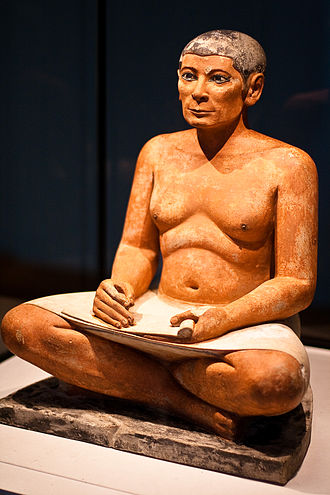I’ve seen a few posts recently on social media, lamenting what they see as a confusing way to present addition. I happen to think that the new presentation is actually a pretty cool way of showing what is going on when you add two large numbers together. But it seems that I may be in a minority here, since it’s regularly billed as “the modern way” or similar, in what is obviously supposed to be a derogatory manner…
So this is a swift diversion from other things to talk about mathematics in ancient Egypt.

Perhaps a quick presentation of the way the ancient Egyptians did multiplication might just help. Egyptian scribes necessarily did a lot of multiplication (volumes of pyramids, rations for armies, taxes due to the pharaoh, and so on). They also realised that addition was significantly easier to learn than multiplication, so converted one into the other. Now, when we first encounter multiplication in school, we are typically taught that it is simply repeated addition – so 4×5 is simply 5+5+5+5. But then we get into multiplying digits, carrying over extra powers of 10 to the next column, and so on, and the early lesson is forgotten. Especially when we can get a calculator app or a spreadsheet to just do it for us.
But actually, the Egyptians basically developed a form of binary representation of numbers – a direct parallel to the way computers represent numbers – and used this to make the task easier.
Let’s take a simple example… say 6×17 – simple enough to follow the logic, but fiddly enough you would probably start writing things down or using your phone app, rather than doing it in your head.
Start by making a table below the 6, starting with 1 and doubling each row until you get over half way towards 6 (in other words, when the next doubling would take you past 6). Beside each of these, under the 17, write 17 in the first row, and every row after that write in double the number before… 17+17=34 in row 2, and so on.
| 6 | 17 |
|---|---|
| 1 | 17 |
| 2 | 34 |
| 4 | 68 |
Then look up and down the left hand column to find which numbers you need to add to 6. Start with the bottom number – the largest – in this case 4. Go up to the next one – 2. I have highlighted them as grey here. You need 4+2, but you don’t need the 1.
Now add up the figures on the right hand side matching your selection on the left… 34+68 = 102. In case you don’t trust yourself, whip out a calculator of some form and check it.
Here’s a more challenging example – 29×59.
| 29 | 59 |
|---|---|
| 1 | 59 |
| 2 | 118 |
| 4 | 236 |
| 8 | 472 |
| 16 | 944 |
To find the matching numbers, start from the bottom of the left-hand column – 16 – and work your way up, deciding which you need to get to 29, Here it is 16, 8, 4, 1 (but not 2). So add up 944, 472, 236 and 59 to get 1711… which again you can check using some other means.
Basically, every multiplication problem can be reduced to addition. How does this work? Basically the figures down the left hand side can be interpreted as the binary representation of 6, or 29, or whatever. This binary mapping is then applied to the right hand side, by repeated doubling… which is just adding a number to itself. For the really geekily minded, it also relies on the fact that multiplication is distributive over addition – so if 6=4+2 then 6×17 = (4+2)x17 = 4×17 + 2×17. And the right hand side of the table is cunningly working out 2×17, 4×17 and so on, by repeated doubling.
Were the Egyptians aware of binary representations and such like? My guess is probably not, though I’m sure there are a lot of people who believe the Egyptians were capable of considerable technological advance.

